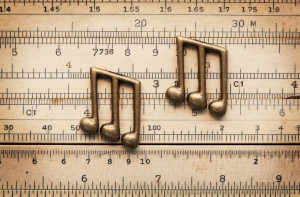5 FAQ’s to Demystify Dithering
WHAT IS DITHERING?
Dithering, in its most basic form, is the addition of very low-level noise to a digital signal in an effort to help improve the sound.
WHY ADD NOISE?
It’s actually a bit of a tradeoff. Introducing noise helps to alleviate the harsh distortion of “quantization errors” that can effect quiet signals, and are especially apparent at low bit-depths.
WHAT IS QUANTIZATION?

Beware quantization distortion, which can cause! (image supplied by Shutterstock)
Quantization is the action of turning a large group of values into a smaller group of values. It happens every time a signal is converted from digital to analog, and during this process, the values are rounded off to the nearest degree of accuracy. This process creates a type of distortion due to these “quantization errors.”
In the realm of digital signal processing, quantization often results in the loss of audio information. As you go from 24-bit to 16-bit, you are reducing the number of values available to measure the dynamic range of the audio.
Subsequently, to some degree, truncation distortion occurs. You’ve most likely heard an example of this unpleasant, fuzzy manifestation before.
Check out the video below for a demonstration of quantization distortion when saving digital audio without dithering:

WHAT ABOUT NOISE SHAPING?
Noise shaping is a way of altering the distribution of the noise so that it has less power in the frequency bands where it is more easily heard, and at a correspondingly higher level in bands where it is less easily heard, and therefore, less problematic.
Many dithering plugins today offer some sort of noise shaping. Some of the most popular algorithms include Prism’s SNS, Apogee’s UV22HR, POW‑R, Sony’s Super Bit‑mapping, and iZotope’s MBIT+.
SHOULD I DITHER?
Working at a 24-bit resolution, as the majority of us do nowadays, quantization distortion is far from noticeable. That doesn’t mean it isn’t there, however. Paul Frindle, a former design engineer at SSL and responsible for product design and quality assurance at Oxford Plugins, has stated, “…every plug-in I have designed has dither on it’s output at 24-bits minimum. The idea is to establish a legitimate intended range for the plug-in when driving stuff further down line and ensuring that the range remains legitimate – and won’t turn into distortion elsewhere in the chain.
“And of course we do this even though internally they are running at native 64bit float – because the signal we deliver has a known and intended range in the real world, just like analogue.. I know that this seems like overkill and people don’t bother, but it’s cheap to do and IS the correct thing to to…”
On the other hand, Ethan Winer of RealTraps has written, “…using dither is never a bad thing, and it can sometimes help on soft material recorded at very low levels. So I’m not arguing against using dither! But I’ve never heard dither make any difference when applied to typical pop music recorded at sensible levels…”
For more on dithering and digital noise floor, check out Justin Colletti’s “Why (Almost) Everything You Thought You Knew About Bit Depth Is Probably Wrong.”
Michael Duncan is a recording and mix engineer who lives in Brooklyn.
Please note: When you buy products through links on this page, we may earn an affiliate commission.







Leigh Marble
January 9, 2015 at 11:58 am (10 years ago)Some key concepts are absent from this article, which would help to fully demystify dither.
Michael D
January 10, 2015 at 2:01 pm (10 years ago)This was just meant to be a basic overview. What else would you like to know?
Leigh Marble
January 13, 2015 at 5:37 pm (10 years ago)One, the article doesn’t explain WHY “introducing noise” is preferable to the “harsh effects” of quantization error. So you’re not demystifying the process, really.
Two, it perpetuates the myth that dithering is the same as adding noise. If it was, then you could truncate (e.g. to 16-bit) first, and then add noise (modulating only the 16th, least-significant bit), and it would be equivalent to dithering. But that is not an equivalent action, and it would not create the same output.